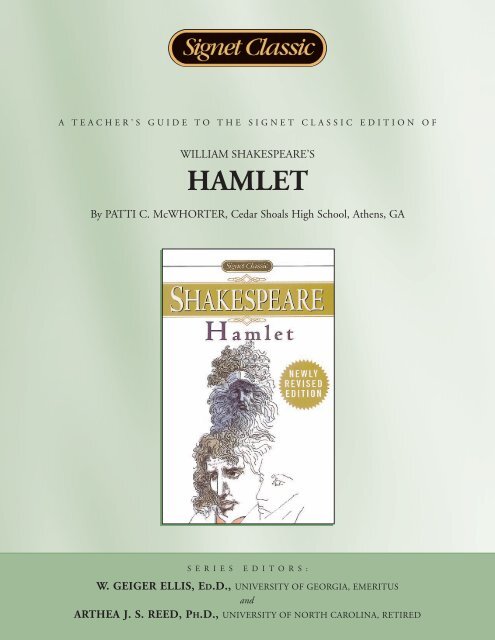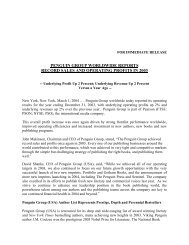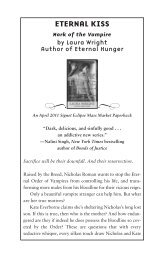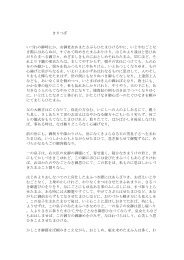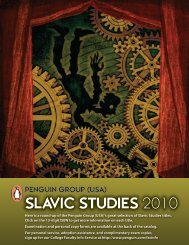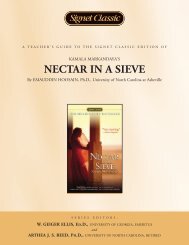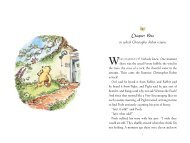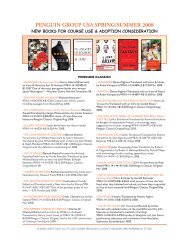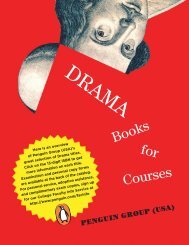Hamlet TG - Penguin Group
Hamlet TG - Penguin Group
Hamlet TG - Penguin Group
Create successful ePaper yourself
Turn your PDF publications into a flip-book with our unique Google optimized e-Paper software.
A TEACHER’S GUIDE TO THE SIGNET CLASSIC EDITION OF<br />
WILLIAM SHAKESPEARE’S<br />
HAMLET<br />
By PATTI C. McWHORTER, Cedar Shoals High School, Athens, GA<br />
SERIES EDITORS:<br />
W. GEIGER ELLIS, ED.D., UNIVERSITY OF GEORGIA, EMERITUS<br />
and<br />
ARTHEA J. S. REED, PH.D., UNIVERSITY OF NORTH CAROLINA, RETIRED
A Teacher’s Guide to the Signet Classic Edition of William Shakespeare’s <strong>Hamlet</strong> 2<br />
INTRODUCTION<br />
The enigmatic qualities of Shakespeare’s Prince <strong>Hamlet</strong> make this drama an appropriate choice for high school students<br />
who can evaluate and analyze the complexity of <strong>Hamlet</strong>’s situation, his motivations, and the choices and decisions he<br />
makes. Students are immediately intrigued by the play, especially if teachers introduce them to the complicated dilemma<br />
of Prince <strong>Hamlet</strong> before they begin reading. Once students are aware of <strong>Hamlet</strong>’s tragic story, they are compelled to learn<br />
what he decides to do and the consequences of his decisions.<br />
<strong>Hamlet</strong> is a monument of Shakespeare’s talent, and as such. Teachers have the exciting opportunity to proceed in infinite<br />
directions in their teaching of the work. The most meaningful focus, however, is to be found in studying the character of<br />
Prince <strong>Hamlet</strong>. As a young man, he is not much older than many of the teenagers who will the play. He is uncertain about<br />
how to deal with the loss of his father, confused about what his actions should be, and angry at most of the adults in his<br />
life. Students of all ability levels should be encouraged to interact with <strong>Hamlet</strong> on personal and analytical levels, providing<br />
a multi-dimensional reading experience.<br />
Included in this guide are activities for students of varying abilities, background on the play, an act-by-act synopsis,<br />
suggestions for organizing instruction, a list of journal writing topics, discussion questions, and activities for use before,<br />
during and after reading the play.<br />
HAMLET: AN OVERVIEW<br />
ACT I<br />
ACT II<br />
SYNOPSIS<br />
Most of the action of play occurs in and around the castle at Elsinore in Denmark. King <strong>Hamlet</strong> is dead, and Prince<br />
<strong>Hamlet</strong> has returned to Denmark from school in Wittenberg, Germany, only to discover that Queen Gertrude, his mother,<br />
has married his Uncle Claudius. Claudius has had himself crowned king.<br />
<strong>Hamlet</strong> is informed that what is apparently the ghost o f his dead father has appeared to the palace guards (I, ii). When<br />
he later confronts the ghost, <strong>Hamlet</strong> learns that Claudius murdered his father and hastily married Queen Gertrude (I, v).<br />
Throughout the play, the ongoing border disputes and political machinations amongst Denmark, Norway, and Poland<br />
serve as a backdrop for the action in the Danish court (I, ii; II, ii; IV, iv; V, ii). Prince Fortinbras, whose father was killed<br />
by <strong>Hamlet</strong>’s father, is a man of action, and his character serves as a foil to the contemplative Prince <strong>Hamlet</strong>.<br />
Polonius (Lord Chamberlain), his son Laertes and daughter Ophelia are also important characters in this drama. Polonius<br />
and Laertes are concerned about Ophelia’s romantic involvement with Prince <strong>Hamlet</strong> and caution her against such a<br />
relationship. Polonius also provides fatherly advice to Laertes as he leaves for Paris (I, iii).<br />
<strong>Hamlet</strong>’s emotional turmoil over his father’s murder has left him in a visibly agitated condition, which some members of<br />
the court have interpreted as madness. Claudius and Gertrude, concerned for his welfare, summon two of <strong>Hamlet</strong>’s oldest<br />
friends, Rosencrantz and Guildenstern, in the hopes that they can learn what is troubling him. (II, ii). <strong>Hamlet</strong> is<br />
immediately skeptical about their surprise visit.<br />
Anxious to confirm his own suspicions regarding the source of <strong>Hamlet</strong>’s trouble, Polonius arranges a meeting between<br />
Ophelia and <strong>Hamlet</strong>, as he is convinced that <strong>Hamlet</strong>’s love for Ophelia is the cause of his suffering (II, ii). When Polonius<br />
approaches <strong>Hamlet</strong>, <strong>Hamlet</strong> answers his questions although he believes Polonius to be a foolish old man.<br />
When a group of players arrives at the Danish court to entertain, <strong>Hamlet</strong> arranges for them to perform The Murder of<br />
Gonzago with the addition of lines <strong>Hamlet</strong> has written. What <strong>Hamlet</strong> hopes is to prove Claudius’s guilt in the murder by<br />
watching his reaction to the drama the players will stage (II, ii).
A Teacher’s Guide to the Signet Classic Edition of William Shakespeare’s <strong>Hamlet</strong> 3<br />
ACT III<br />
ACT IV<br />
ACT V<br />
When Rosencrantz and Guildenstern report back to Claudius that they have no explanation for <strong>Hamlet</strong>’s strange behavior,<br />
Claudius decides to eavesdrop with Polonius on the meeting between <strong>Hamlet</strong> and Ophelia. Although <strong>Hamlet</strong> treats<br />
Ophelia irrationally, Claudius is suspicious of his behavior and makes plans to sent <strong>Hamlet</strong> to England (III, i).<br />
The players perform their drama in which the events portrayed, with <strong>Hamlet</strong>’s alterations, almost duplicate the<br />
circumstances surrounding King <strong>Hamlet</strong>’s death. <strong>Hamlet</strong> observes that Claudius is visibly upset by the play. When he<br />
leaves abruptly, Claudius confirms his guilt in the eyes of <strong>Hamlet</strong> and his friend, Horatio (III, ii).<br />
Out of concern for <strong>Hamlet</strong>’s welfare, Queen Gertrude meets privately with her son in her chambers. Polonius, however,<br />
is eavesdropping behind a wall tapestry. <strong>Hamlet</strong>’s rebukes cause Gertrude to cry out, and Polonius cries out as well, fearful<br />
for her welfare. Believing he has heard Claudius, <strong>Hamlet</strong> stabs through the tapestry, killing Polonius (III, iv).<br />
Polonius’s death provides Claudius with the opportunity to send <strong>Hamlet</strong> to England, under the false pretense of<br />
protecting his life, when in reality, he has asked the King of England to kill Prince <strong>Hamlet</strong> (IV, iii). Grief-stricken b y their<br />
father’s death, Laertes and Ophelia solicit Claudius’s assistance in finding his murderer (IV, v). Meanwhile, <strong>Hamlet</strong> sends<br />
word to Horatio that he has been taken prisoner by pirates who have returned him to Denmark and asks Horatio to join<br />
him (IV, vi). In order to remove <strong>Hamlet</strong> as a threat, Claudius now plans an exhibition duel in which Laertes will use a<br />
sword tipped with poison (IV, vii).<br />
Ophelia’s madness and subsequent drowning (IV, v; IV, vii) precipitate a confrontation between Laertes and <strong>Hamlet</strong> at<br />
her grave (V, I), but Claudius intervenes, privately assuring Laertes that his revenge will come in the duel which has been<br />
arranged. <strong>Hamlet</strong> seals the fate of Rosencrantz and Guildenstern by substituting another letter in the envelope which<br />
originally contained his own death orders, requesting that the King of England put them to death (V, ii). In spite of<br />
Horatio’s concern, <strong>Hamlet</strong> agrees to the duel with Laertes and appears before the court as requested. Not only does<br />
Claudius poison the tip of the sword, he also offers <strong>Hamlet</strong> a drink from a poison cup. Instead, Gertrude drinks from the<br />
cup and swoons from the effect of the poison, her dying words warning <strong>Hamlet</strong> of the plot against him. As the duel<br />
progresses, Laertes and <strong>Hamlet</strong> inadvertently exchange swords during a scuffle; consequently, both are mortally wounded,<br />
although <strong>Hamlet</strong> manages to fatally wound Claudius as well.<br />
As the play closes, Fortinbras arrives, victorious over Poland, and the dying <strong>Hamlet</strong> names him as the new king. Fortinbras<br />
pays tribute to <strong>Hamlet</strong> and arranges for an appropriate burial.<br />
ELEMENTS OF TRAGEDY IN HAMLET<br />
By Shakespeare’s time, the characteristics of tragedy in drama had been redefined. In the plays of the early Greeks, the<br />
tragic hero was a noble man who rose to the heights of success only to be plummeted to defeat and despair by his own<br />
tragic flaw, or hamartia. The plot structure in these early tragedies was relatively straightforward; the motive of the<br />
dramatist was to elicit pity and terror from the audience through empathy with the tragic hero.<br />
What once had been a relatively simple form was gradually altered by playwrights to allow for more depth in<br />
characterization, more flexibility in plot structure, and the element of comic relief. <strong>Hamlet</strong>’s situation, for example, is<br />
considered a tragic one although it differs from the relatively simple plots found in the earlier Greek tragedies. He is a<br />
nobleman, revered by his countrymen, who strives to alter the world around him. Ultimately, he must forfeit his own life<br />
to see justice done. The plot that unfolds in Shakespeare’s drama includes politics, murder, and domestic strife, but still<br />
evokes pity and terror in the audience, precisely as intended by the early tragedians.<br />
Students can analyze the elements of tragedy in <strong>Hamlet</strong>, comparing and contrasting Prince <strong>Hamlet</strong>’s plight with that of<br />
tragic heroes in Greek tragedies and in modern tragedies. Suggested modern tragedies for such a comparison include<br />
Death of a Salesman, by Arthur Miller, and Mourning Becomes Electra, by Eugene O’Neill.<br />
Note: More detailed information about Elizabethan tragedy can be found in the Introduction by Edward Hubler in the<br />
Signet Classic edition of <strong>Hamlet</strong>.
A Teacher’s Guide to the Signet Classic Edition of William Shakespeare’s <strong>Hamlet</strong> 4<br />
HISTORICAL CONTEXT OF HAMLET<br />
Students will be interested to know that the story of Prince <strong>Hamlet</strong> was not original with Shakespeare’s version. The basic<br />
plot was found in ancient stories which eventually made their way to Scandinavia, specifically Denmark. The Signet<br />
Classic edition contains more specific background on the origins of this story in "A Note on the Sources of <strong>Hamlet</strong> " and<br />
in Sylvan Barnet’s prefatory remarks. Barnet also includes more general information about Shakespeare, the Elizabethan<br />
theater, and the various texts of <strong>Hamlet</strong>. Suggested teaching strategies utilizing this information are included in the<br />
activities for use before reading the play.<br />
SHAKESPEARE’S LANGUAGE<br />
The enormous contribution which William Shakespeare has made to the English language is evidenced in the volumes of<br />
scholarly endeavor devoted to his body of works and in the direct and indirect allusions to his words in contemporary<br />
language and culture. A richness in imagery and an ability to tap the depths of meaning in every word make the reading<br />
of a Shakespearean play more than memorable.<br />
Students who read <strong>Hamlet</strong> after reading other plays by Shakespeare have often previously studied Elizabethan language<br />
and have some awareness of the changes which have taken place in word meaning and usage over the centuries. This<br />
background should serve them well as they become involved in the power of the language of <strong>Hamlet</strong>. The suggested<br />
activities which follow are intended to involve students in discovering the historical impact of Shakespeare’s <strong>Hamlet</strong> and<br />
appreciating his extraordinary talent.<br />
ACTIVITIES FOR DISCOVERING AND APPRECIATING SHAKESPEARE’S LANGUAGE<br />
The imagery in the play which supports the impression of decay and corruption in Denmark is woven throughout the<br />
speeches and dialogue. Students can be divided into groups, each group assigned a different act and instructed to locate<br />
as many references to decay and corruption as possible. Students should then explore the context of these references and<br />
determine to what extent these specific images enhance the overall meaning of the play. (Note: An activity such as this<br />
will sometimes necessitate a review of figurative language, the terminology and the purpose of literary devices such as<br />
symbol, metaphor, simile, etc. Teachers should assess the extent to which students need such a review prior to assigning<br />
this group activity.)<br />
<strong>Group</strong>s should share their findings with the class, with all students noting and discussing the pattern of these images as<br />
they recur throughout the play.<br />
Structure group research activities devoted to the study of Elizabethan language, its unusual conventions and forms.<br />
Students can build on prior knowledge or begin new investigations. The publication by Randal Robinson cited at the end<br />
of this guide is an exceptional collection of classroom activities designed to assist students in understanding Shakespeare’s<br />
language.<br />
The most impressive evidence of Shakespeare’s power over the English language, even today, is the abundance of allusions<br />
to his works which have become permanent fixtures in our language. Students should be challenged to listen and watch<br />
for these allusions in all forms of media, in the language of people around them, and in the literature they study. A list of<br />
possibilities follows:<br />
Absent thee from felicity awhile (V, i)<br />
All is not well (I, ii)<br />
The bird of dawning singeth all night long (I, i)<br />
Brevity is the soul of wit (II, ii)<br />
Frailty, thy name is woman! (I, ii)<br />
Give me that man/That is not passion’s slave (III, ii)<br />
Give thy thoughts no tongue (I, iii)<br />
How all occasions do inform against me (IV, iv)<br />
I am sick at heart (I, i)<br />
I could a tale unfold (I, v)
A Teacher’s Guide to the Signet Classic Edition of William Shakespeare’s <strong>Hamlet</strong> 5<br />
In my mind’s eye (I, ii)<br />
It cannot come to good (I, ii)<br />
It started like a guilty thing (I, i)<br />
The lady doth protest too much (III, ii)<br />
Lay not that flattering unction to your soul. (III, iv)<br />
Leave her to heaven (I, v)<br />
Like sweet bells jangled, out of tun and harsh (III, i)<br />
Man delights not me;/nor woman neither (II, ii)<br />
More honoured in the breach than the observance (I, iv)<br />
More in sorrow than in anger (I, ii)<br />
More matter, with less art (II, ii)<br />
Neither a borrower, nor a lender be (I, iii)<br />
Not a mouse stirring (I, i)<br />
Now cracks a noble heart, Good-night, sweet prince,<br />
And flights of angels sing thee to thy rest? (V, ii)<br />
O, my offence is rank, it smells to heaven (III, iii)<br />
O my prophetic soul! (I, v)<br />
The primrose path of dalliance treads<br />
And recks not his own rede (I, iii)<br />
The rest is silence (V, ii)<br />
Rosemary, that’s for remembrance IV, v)<br />
The slings and arrows of outrageous fortune (III, i)<br />
Something is rotten in the state of Denmark. (I, v)<br />
So much for him (I, ii)<br />
Sweets to the sweet; farewell! (V, i)<br />
That it should come to this! (I, ii)<br />
There are more things in heaven and earth, Horatio,<br />
Than are dreamt of in your philosophy. (I, v)<br />
There’s a divinity that shapes our ends (V, ii)<br />
This too too solid flesh (I, ii)<br />
Thus conscience does make cowards of us all (III, i)<br />
‘Tis bitter cold (I, i)<br />
‘Tis true: ‘tis true ‘tis pity,<br />
And pity ‘tis ‘tis true (II, ii)<br />
To be, or not to be: that is the question (III, i)<br />
To die, to sleep—No more (III, i)<br />
T’ have seen what I have seen, see what I see! (III, i)<br />
To sleep; perchance to dream (III, i)<br />
To thine own self be true (I, iii)<br />
‘Twas/caviare to the general (II, ii)<br />
We know what we are, but<br />
know not what we may be (IV, v)<br />
What a piece of work is man (II, ii)<br />
When sorrows come, they come not single spies,<br />
But in battalions (IV, v)<br />
Students can write paraphrases of <strong>Hamlet</strong>’s soliloquies or translate them into contemporary language either as individuals<br />
or in small groups. These can be "performed" for the class.
A Teacher’s Guide to the Signet Classic Edition of William Shakespeare’s <strong>Hamlet</strong> 6<br />
SUGGESTIONS FOR ORGANIZING INSTRUCTION<br />
A motivating introduction and activities designed for all ability levels can make <strong>Hamlet</strong> accessible to every student. The<br />
following are suggestions for organizing the instruction for any ability level of student, and then more specific<br />
recommendations for use with those with advanced and nonacademic ability levels.<br />
ALL ABILITY LEVELS<br />
A. Journal writing is an essential part of an English classroom, especially with works of literature. At a glance, teachers can<br />
readily assess whether a student has read and understood a work. Students should be encouraged or required to write in<br />
their journals throughout the study of the play, detailing their personal reactions to particular characters or situations or<br />
writing in response to assigned topics like those below. Have students relate each topic they write on to characters or<br />
situation in the play.<br />
Journal Topics<br />
• How common do you believe the act of revenge is in everyday life? Write about specific incidents, including any in<br />
which you were involved or have witnessed.<br />
• Find magazine/newspaper articles, short stories, plays, poems, or novels containing events motivated by revenge.<br />
How might events have been changed had someone not sought revenge?<br />
• Characterize yourself as a "thinker" or a "doer." In this respect what character in the play are you most like? How<br />
would you like to be different, or would you like to be different?<br />
• Have you or anyone you have known ever seen or claimed to have witnessed some kind of supernatural being?<br />
Explain the circumstances surrounding the even. Do you believe in the supernatural? Explain.<br />
• In Act I, scene iii of <strong>Hamlet</strong>, Polonius gives Laertes a great deal of "fatherly advice" about how to live his life. Look<br />
at this section and find advice you have heard from your own parents. How valuable is this advice? Have you used<br />
it? Have you been involved in any situation to which this advice was applicable?<br />
• To what extent do parents have the right to "spy" or check up on their children? What circumstance might allow or<br />
prevent this?<br />
• How are relationships between stepparents and stepchildren generally depicted in fiction or film? Do you have any<br />
experience with or knowledge of step-relationships? What conflicts and barriers must be overcome? What are the<br />
advantages, the positive aspects of these relationships?<br />
• Are parents generally blind to their children’s faults? Why or why not?<br />
• King Claudius states "Madness in great ones must not unwatched go." (III, i) How is this true in any age? What<br />
evidence can you find in recent news stories to support this statement? How do societies keep checks and balances<br />
on their "great ones?"<br />
• So you know what an "apple polisher" is? Have you every known one or been one yourself? Why do you think people<br />
do this? How do you feel about it?<br />
• Have you ever been the victim of unrequited love? How did you feel? Have you ever been the recipient of affection<br />
from someone whom you did not care about? How did you feel about this situation?<br />
• Write about a time when you discovered that someone was purposefully plotting against you for some reason. Explain<br />
the situation—how you felt, how it turned out.<br />
B. Using small groups in the regular classroom can serve several functions. <strong>Group</strong>s containing mixed ability levels can work<br />
on study questions, summarize scenes, prepare presentations, work on projects, and aid each other in deciphering more<br />
difficult sections of the play. These same groups can also serve as peer groups for various writing activities.<br />
<strong>Group</strong> activities should be structured carefully for students on all ability levels. Teachers should provide groups with<br />
specific directions and expectation for each task, reasonable (but flexible) time limits, and follow-up activities connecting<br />
group work to the broader objectives for teaching the play.
A Teacher’s Guide to the Signet Classic Edition of William Shakespeare’s <strong>Hamlet</strong> 7<br />
UPPER-ABILITY LEVELS<br />
More capable students can be assigned to read the play prior to intensive act-by-act analysis with the teacher. Students<br />
should keep a reading journal summarizing what they have read, writing down questions about any aspect of the play, and<br />
responding to the actions of the characters and the plot.<br />
A second reading of the play is desirable. After the initial reading students may re-read each act, focusing attention on<br />
specifics through the use of study/discussion questions or group activities.<br />
LOWER-ABILITY LEVELS<br />
A. With some students, reading the play aloud and summarizing the major actions scene-by-scene is necessary for<br />
comprehension. Care must be taken not to cover too much in one-class period. To avoid monotony, other teaching<br />
strategies such as the following should be used on occasion:<br />
• Assigning manageable sections of the play to small groups, and having students prepare to read aloud and interpret<br />
these sections for the class.<br />
• Viewing a videotaped production of the play prior to studying the written drama, or viewing the play scene-by-scene<br />
and then summarizing and discussing.<br />
B. The use of study/discussion questions is appropriate with all levels of students. However, lower-ability students need to<br />
answer more surface-level comprehension questions before moving to the levels of analysis and synthesis. Such questions<br />
can establish the essentials of plot, setting, and character. Here are some examples:<br />
• What characters are present when the play opens?<br />
• Where are they?<br />
• What have they seen that is unusual?<br />
• What do they decide to do?<br />
Thought-provoking questions worded to promote understanding can be employed as well. These students can become<br />
equally involved with <strong>Hamlet</strong>’s dilemma if they are afforded an appropriate entry through engaging questions and<br />
activities such as those which follow.<br />
BEFORE READING THE PLAY<br />
Having students consider some major conflicts in the play prior to reading can help establish a basis on which to build<br />
their knowledge of the play. Some useful activities might include one or more of the following:<br />
Journal writing on topics related to the conflicts and events in the play is one way students can become interested and<br />
involved in the issues and topics in the play. Students should be given the opportunity to share and discuss the ideas they<br />
express in their journals. (See the topics noted in "Suggesting for Organizing Instruction.")<br />
Bring in magazine and/or newspaper articles containing examples of people seeking revenge. Students can read these and<br />
draw parallels between the events in the articles and those in the play. This activity might be done in small groups with a<br />
follow-up journal writing and class discussion. (The second journal topic included previously asks students to bring in<br />
examples of the role revenge plays in their lives.)<br />
Teachers talented at writing scripts might modernize the basic plot line of <strong>Hamlet</strong> in a simple reader’s theater script,<br />
perhaps as an afternoon soap opera, and have students present the drama to the class. A follow-up to this activity might<br />
include a class discussion in which students examine how the plot unfolds. A subsequent writing assignment, in the form<br />
of a journal entry or a more structured composition, could be appropriate.<br />
Students might be interested in reading "A Note on the Sources of <strong>Hamlet</strong>" included in the Signet Classic edition prior<br />
to studying the play. A succinct background on the origins of the <strong>Hamlet</strong> story, this information might be summarized<br />
and presented by the teacher or assigned to a small group for presentation to the class.<br />
Note: This activity in isolation from one or more of the preceding activities will not allow students to become personally<br />
involved with the issues of the play, a necessary step for a fuller appreciation and understanding of literature.
A Teacher’s Guide to the Signet Classic Edition of William Shakespeare’s <strong>Hamlet</strong> 8<br />
AS THE PLAY IS READ<br />
CONSIDERING MAJOR THEMES<br />
Through class discussion and other activities, students can discover how Shakespeare develops major themes in the play<br />
which include:<br />
• Revenge: <strong>Hamlet</strong> searches continuously for the answer to the question of whether or not he should avenge his father’s<br />
death. His concern with right and wrong in religious, moral, and political terms causes him much inner turmoil.<br />
(Journal Topics 1, 2)<br />
• Appearance vs. Reality: The play contains many situations in which the surface appearance of things does not always<br />
match reality. <strong>Hamlet</strong> struggles to determine who his true friends are; the players in the acting troupe assume new<br />
identities; Claudius appears to be a true and just king and Gertrude his virtuous queen. (Journal Topics 4, 8, 10, 11)<br />
• Sanity vs. Insanity: In many ways this conflict is intertwined with the theme of appearance vs. reality. <strong>Hamlet</strong>’s sanity<br />
or insanity has baffled critics for years. Even the characters in the play discuss inconsistencies in <strong>Hamlet</strong>’s behavior,<br />
sometimes assuming he is really insane, at other times amazed by his clarity of thought. (Journal Topics 3, 9)<br />
• Decay and Corruption: Among the most powerful images of the play are those which reveal disintegrating situations,<br />
both in personal terms for Prince <strong>Hamlet</strong>, and in political terms for Denmark. (Journal Topics 1, 2, 9, 12)<br />
ACTIVITIES FOR DISCOVERING THEMES<br />
Assign appropriate journal topics for leading into the discussion of a particular theme as it is evidenced in the play. (See<br />
above list of themes.<br />
Provide students with a handout listing themes to be found. Advanced students can be instructed to note specific passages and<br />
situations that develop these ideas. A simpler approach for less skilled readers is to hand out a list of page numbers where<br />
important passages related to themes are found and requiring the students to locate the passages and note their significance.<br />
Organize students into small groups, assigning each group a different theme. Allow time for groups to collaborate on a<br />
class presentation of this particular theme as it is found in <strong>Hamlet</strong>. <strong>Group</strong>s can present the important passages to the class,<br />
perhaps in the form of a handout or an overhead transparency. They might also include a dramatization and discussion<br />
of selected passages related to their assigned theme. <strong>Group</strong>s can develop a list of study questions, both short answer and<br />
essay, to guide others in discovering this theme in <strong>Hamlet</strong>.<br />
Progressing through the Play: In lieu of a list of questions, have students summarize each scene as they read, either in<br />
writing or orally for the class. As a variation on the reading journal/log, have students make a chart for each scene in which<br />
they list primary characters, major actions and conflicts, resolutions, significant references to themes, recurring images,<br />
and questions. After students have read Acts I and II, allow small groups to write modern versions of the significant scenes<br />
or incidents in the play and present these to the class.<br />
Using Study/Discussion Questions: Listed by the traditional elements of fiction (character analysis, plot, theme), the<br />
following study/discussion questions can be used to engage students in class discussion or writing, or small groups of<br />
students can deal with specific questions and present their observations to the class.<br />
STUDY/DISCUSSION QUESTIONS<br />
CHARACTER ANALYSIS<br />
The following phrases might be used to describe the character of Prince <strong>Hamlet</strong>. How do you think each relates to<br />
<strong>Hamlet</strong>’s nature? Refer to the text for support.<br />
• a victim of circumstance<br />
• a man incapable of taking action
A Teacher’s Guide to the Signet Classic Edition of William Shakespeare’s <strong>Hamlet</strong> 9<br />
• an excessively ambitious prince who lusts for power<br />
• a person of exceptional intellect and intelligence<br />
• a man in the grip of insanity<br />
Consider <strong>Hamlet</strong>’s behavior when he is with each of the following characters. What is revealed about him in his dealings<br />
with each of these people?<br />
• Claudius<br />
• Gertrude<br />
• Ophelia<br />
• Horatio<br />
• Polonius<br />
• Rosencrantz and Guildenstern<br />
What developments and/or states of mind do each of <strong>Hamlet</strong>’s six soliloquies reveal? (I, ii; II, ii; III, i; III, iii; IV, iv)<br />
How do you explain <strong>Hamlet</strong>’s inability to act in avenging his father’s death?<br />
Is <strong>Hamlet</strong> a likable character? Would you want to be his friend? Explain.<br />
What questions do you have about the character of <strong>Hamlet</strong>? What problems do you see in analyzing his character? Do<br />
you admire Shakespeare’s ability to develop a character, or do you think he leaves too many questions unresolved?<br />
PLOT<br />
When the play begins, a major event, the death of King <strong>Hamlet</strong> has already occurred. How does this affect the reader’s<br />
understanding of the play?<br />
What purposes do the subplots of the relationship between Polonius and his children and the political situation with<br />
Norway and young Fortinbras serve? How is the story of Prince <strong>Hamlet</strong> and his particular situation reflected in each of<br />
these subplots?<br />
Look carefully at each act of the drama. What is the function of each? What important event or situation is developed in<br />
each act by Shakespeare?<br />
How does Shakespeare keep his audience apprised of developments outside the primary action of the play? Why are events<br />
on the ship taking <strong>Hamlet</strong> to England not portrayed? Find other examples in the play where Shakespeare keeps his readers<br />
aware of important events, but does so without presenting the action in the drama. Is this appropriate in your opinion?<br />
Why or why not?<br />
Did you find the action in the play difficult to follow? Where? What did you find challenging about these sections?<br />
Consider the dramatic pacing of the play. Does Shakespeare keep the audience or reader involved in the action? How?<br />
Explain your opinion.<br />
THEME<br />
To what extent is <strong>Hamlet</strong>’s quest for revenge justifiable in terms of the situation presented? Why or why not?<br />
Find evidence of <strong>Hamlet</strong>’s religious beliefs. How do these beliefs influence his actions and decisions?<br />
Examine the characters and events in terms of appearance and reality. Cite examples of things that are not what they seem.<br />
Find examples of imagery that reveal decay or corruption. What effect do these images have on the reader? How would<br />
you explain Shakespeare’s inclusion of these images in the play?<br />
Explain what you think is revealed about human nature in <strong>Hamlet</strong>. Use characters and situations to illustrate your points.
A Teacher’s Guide to the Signet Classic Edition of William Shakespeare’s <strong>Hamlet</strong> 10<br />
AFTER READING THE PLAY<br />
Provide students with a variety of topics from which they can select a focus for a writing assignment. If students have been<br />
allowed to respond to characters and events in the play on a personal level, perhaps in the form of journal writing as the<br />
play was read, they can develop these topics into a critical expository essay.<br />
Suggested essay topics:<br />
• Determine if, in your opinion, the character of Prince <strong>Hamlet</strong>, is a believable one.<br />
• Compare and contrast the character of <strong>Hamlet</strong> to that of Horatio, Laertes, and/or Fortinbras.<br />
• Consider the women in the play, and assess Shakespeare’s portrayal of them.<br />
• Analyze Shakespeare’s use of subplots in this play. (Examples include the relationship between Polonius and his<br />
children and the political events in Denmark.) Discuss the strengths and/or weaknesses of this technique and<br />
determine if it was appropriate in this play.<br />
• Of the themes presented in <strong>Hamlet</strong>, decide which was most important and justify your selection.<br />
The commentaries included in the Signet Classic edition are especially useful with more advanced readers. These can be<br />
assigned for précis writing, journal responses, or both.<br />
Note: One way to organize the journal responses is to have students divide their journal page in half vertically, with the<br />
left side reserved for jotting down interesting or controversial statements made by the critics or provocative lines from the<br />
play, and the right side reserved for their own personal observations about these statements. In this way, the information<br />
is easily referenced for later use in class discussions, group projects, and/or writing assignments.<br />
Students can extend their learning by researching any aspect of Shakespeare’s theater. If this has been done extensively in<br />
a prior study of Shakespeare, students can research broader topics related to the play. Such topics might include parentchild<br />
relationships, stepfamilies, the supernatural, or the occult.<br />
Students can modernize selected portions of the play and perform these for class. Possible situations might include:<br />
<strong>Hamlet</strong>’s first encounter with his father’s ghost (I, iv), <strong>Hamlet</strong>’s third soliloquy (III, i), or the final death scene (V, ii).<br />
Involving students in artistic projects based on the play is an appropriate way to end the study. Most of the following ideas<br />
are easily adaptable to group work.<br />
• Mini-posters containing a quotation from the play with appropriate artwork or collages.<br />
• Collages focusing on an individual character or one of the themes of the play.<br />
• Dioramas/shadow boxes depicting a significant scene in the play.<br />
• Many parallels have been drawn between the character of Oedipus in Sophocles’s drama and that of <strong>Hamlet</strong>. Students<br />
can read Oedipus Rex and compare his plight to that of <strong>Hamlet</strong>’s.<br />
• Show a videotape or film of the play. Involve students in writing movie reviews of the production or in<br />
comparison/contrast papers based on the written drama and the video production. If time allows and different videos<br />
are available, allow students to compare/contrast these in writing and/or class discussion.<br />
Suggested questions for comparing the drama and video production:<br />
• Did the production look like what you imagined as you read the play? How was it similar? Different?<br />
• Which actor/actress best portrayed his/her character? Why?<br />
• How was the production different from the written drama? What decisions did the director make about staging?<br />
Were these effective decisions?<br />
Sylvan Barnet’s "<strong>Hamlet</strong> on Stage and screen," included in the Signet Classic edition is an excellent overview of the different<br />
stage and film presentations of <strong>Hamlet</strong>. Students can read the article and discuss or write about which presentation they<br />
believe would be the most effective.
A Teacher’s Guide to the Signet Classic Edition of William Shakespeare’s <strong>Hamlet</strong> 11<br />
Another way to utilize this article is to organize the class into small groups and present students with the task of "cutting"<br />
the drama to a length manageable for a television production, approximately two hours. Have them decide what portions<br />
of the play could be deleted and present their views before the class.<br />
Have students write a dialogue that might take place between Prince <strong>Hamlet</strong> and a psychologist. Small groups can write<br />
dialogue for therapy sessions that might take place at different stages during <strong>Hamlet</strong>’s mental turmoil, for example:<br />
• when he learns of his mother’s marriage to his uncle.<br />
• immediately after seeing his father’s ghost for the first time.<br />
• after killing Polonius.<br />
• when he learns of Rosencrantz’s and Guildenstern’s intentions.<br />
• after Ophelia’s funeral.<br />
The study and comparison of a modern work to that of Shakespeare can take students beyond the scope of <strong>Hamlet</strong>. Students<br />
can write comparison/contrast essays or prepare class presentations. An appropriate selection for such activities would<br />
Rosencrantz and Guildenstern Are Dead by Tom Stoppard, in which <strong>Hamlet</strong> is presented from an opposing viewpoint.<br />
SUGGESTED REFERENCES<br />
At the end of the Signet Classic edition is a list of suggested references on Shakespeare including biographical information,<br />
the Elizabethan theater, and <strong>Hamlet</strong>.<br />
TEACHING SHAKESPEARE<br />
Alling, Eliza. "Dear Will." Shakespeare Quarterly 25 (1974): pp. 264-271.<br />
Dean, James S. "What’s the Matter with <strong>Hamlet</strong> in the Schools." In Shakespeare in the Classroom: Resources and Media Aids,<br />
edited by A. McLean, pp. 16-30. Kenosha: UW-Parkside’s Center for Teaching Excellence, 1977.<br />
Hellenga, Robert R. "<strong>Hamlet</strong> in the Classroom." College English 35 (October 1973): pp. 32-39.<br />
Robinson, Randal. Unlocking Shakespeare’s Language: Help for the Teacher and Student. Urbana: National Council of<br />
Teachers of English, 1989.<br />
Sacks, Claire, and Whan, Edgar, eds. <strong>Hamlet</strong>: Enter Critic. New York: Appleton-Century-Crofts, 1960.<br />
HAMLET IN FILM<br />
Ashworth, John. "Olivier, Freud and <strong>Hamlet</strong>." Atlantic Monthly 183 (May 1949): pp. 30-33.<br />
Halio, Jay L. "Three Filmed <strong>Hamlet</strong>s." Literature/Film Quarterly 1 (Fall 1973): pp. 316-320.<br />
BEYOND THE PLAY<br />
Students who are interested in the ideas presented in Shakespeare’s <strong>Hamlet</strong> can find adolescent novels which deal with<br />
these same ideas in more contemporary terms. The following sources are helpful to both teachers and students in locating<br />
books on various topics:<br />
Abrahamson, Richard F. and betty Carter, eds. Books for You: A Booklist for Senior High Students. Urbana: National Council<br />
of Teachers of English, 1988<br />
Davis, James E. and Hazel K. Davis, eds. Your Reading: A Booklist for Junior High and Middle School Students. Urbana:<br />
National Council of Teachers of English, 1988
A Teacher’s Guide to the Signet Classic Edition of William Shakespeare’s <strong>Hamlet</strong> 12<br />
ABOUT THE AUTHOR OF THIS GUIDE<br />
PATTI C. McWHORTER is Chair of the English Department at Cedar Shoals High School in Athens, Georgia. For over ten<br />
years she has been the editor of "Bookcorner," a column in the Counselor, a quarterly publication of the Georgia Council<br />
of Teachers of English. Her publications include articles and reviews for The ALAN Review, Georgia Journal, and English<br />
Journal. She has also served on NCTE’s committee to revise high Interest-Easy Reading and was president of the Georgia<br />
Council of Teachers of English. Patti received her undergraduate degrees and her Ed.D. from the University of Georgia.
ABOUT THE EDITORS OF THIS GUIDE<br />
W. GEIGER ELLIS, Professor Emeritus, University of Georgia, received his A.B. and M.Ed. degrees from the University of North Carolina<br />
(Chapel Hill) and his Ed.D. from the University of Virginia. His teaching focused on adolescent literature, having introduced the first<br />
courses on the subject at both the University of Virginia and the University of Georgia. He developed and edited The ALAN Review.<br />
ARTHEA (CHARLIE) REED, PH.D. is currently a long-term care specialist with Northwestern Mutual Financial Network and senior<br />
partner of Long-Term Care and Associates. From 1978 to 1996 she was a professor of education and chairperson of the Education<br />
Department at the University of North Carolina at Asheville. She is the author or co-author of 15 books in the fields of adolescent<br />
literature, foundations of education, and methods of teaching. She was the editor of The ALAN Review for six years and president of the<br />
Assembly on Literature for Adolescents of the National Council of Teachers of English (ALAN). She is currently co-authoring the 5th<br />
edition of A Guide to Observation, Participation, and Reflection in the Classroom (McGraw-Hill 2004). She has taught almost every grade<br />
from second grade through doctoral candidates. She lives in Asheville, North Carolina with her husband Don, two dogs, and a cat.<br />
FREE TEACHER’S GUIDES<br />
A full list of Teacher’s Guides and Teacher’s Guides for the Signet Classic Shakespeare Series<br />
is available on <strong>Penguin</strong>’s website at:<br />
www.penguin.com/academic<br />
TEACHER’S GUIDES<br />
Animal Farm • Anthem • Beloved • Beowulf • The Call of the Wild • Cannery Row • City of God • The Country of the<br />
Pointed Firs and Other Stories • The Crucible • Death of a Salesman • Dr. Jekyll and Mr. Hyde • Dubliners • Ethan Frome •<br />
The Fountainhead • Girl in Hyacinth Blue • The Grapes of Wrath • A Journey to the Center of the Earth • The Jungle •<br />
The Life of Ivan Denisovich • Looking Backward • Lysistrata • Main Street • Of Mice and Men • The Mousetrap and<br />
Other Plays • A Narrative of the Life of Frederick Douglass, An American Slave • Nectar in a Sieve • 1984 • The Odyssey •<br />
The Passion of Artemisia • The Pearl • Persuasion • The Prince and the Pauper • A Raisin in the Sun • The Red Pony • Redwall •<br />
The Scarlet Letter • The Scarlet Pimpernel • Silas Marner • A Tale of Two Cities • The Time Machine • Up from Slavery •<br />
The Women of Brewster Place • Wuthering Heights<br />
TEACHER’S GUIDES FOR THE SIGNET CLASSIC SHAKESPEARE SERIES<br />
Antony and Cleopatra • As You Like It • <strong>Hamlet</strong> • Henry V • Julius Caesar • King Lear • Macbeth • Measure for Measure •<br />
A Midsummer Night’s Dream • Much Ado About Nothing • Othello • Richard III • Romeo and Juliet • The Taming of<br />
the Shrew • The Tempest • Twelfth Night<br />
Visit the <strong>Penguin</strong> <strong>Group</strong> (USA) web site at www.penguin.com to browse all Signet Classic paperback editions<br />
and www.penguin.com/scessay for information about the Annual Signet Classic Scholarship Essay Contest


